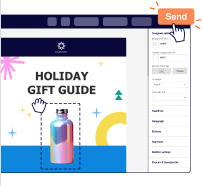Did you know email marketing generates an average return of $36 for every $1 spent? That’s why it remains one of the most profitable marketing channels in 2025.
So what is email marketing? At its core, it’s a digital strategy that involves sending targeted messages to groups of people via email, whether for promotional, informational, or relationship-building purposes. Its effectiveness comes from direct communication with interested audiences, making it uniquely email marketing cost effective compared to other marketing approaches.
No matter the size of your business, if you’re trying to figure out how much you’ll need to budget, you’ve come to the right place. This guide breaks down everything you need to know about email marketing expenses without the fluff.
Understanding Email Marketing Costs
Email marketing costs vary based on several factors: your list size, how often you send emails, what features you need, and whether you handle campaigns yourself or hire someone else. Smart businesses plan their email marketing budgets strategically, thinking about both immediate costs and long-term benefits.
Many organizations choose email marketing specifically because it costs less than other digital marketing channels like direct mail. Unlike paid ads that require constant funding to maintain visibility, email marketing helps you build owned media channels through which you can communicate with your audience at a relatively stable cost over time.
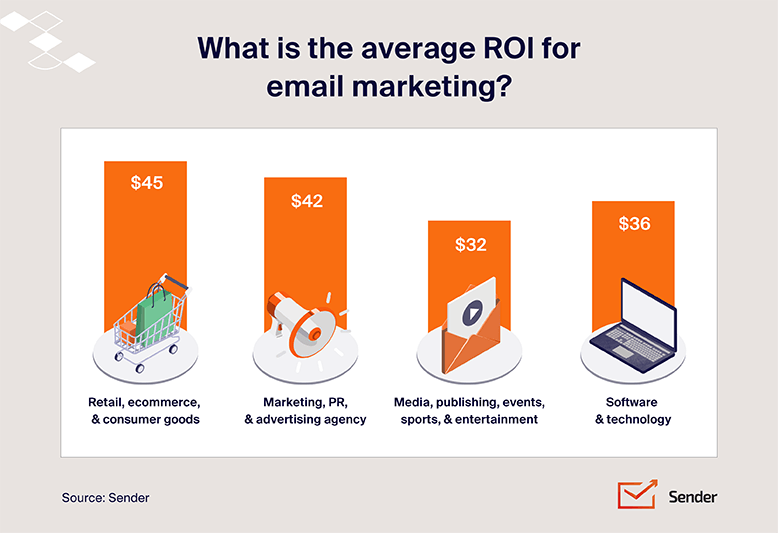
When you invest in email marketing—through subscription fees, training your in house team, or creating valuable content—you’re building lasting customer relationships, not just making a one-time purchase.
Email Marketing ROI: Is It Worth the Investment?
Email marketing consistently outperforms other marketing channels when it comes to return on investment (ROI). Recent email marketing statistics reveal impressive returns across different industries:
- Retail and e-commerce: $45 return per $1 spent
- Financial services: $36 return per $1 spent
- Healthcare: $27 return per $1 spent
- Travel and hospitality: $40 return per $1 spent
These numbers explain why companies spend significant portions of their marketing budgets on email campaigns despite having so many other marketing options, according to Litmus’s 2024 State of Email Report.
Take NightOwl Electronics as an example. This mid-sized retailer started using segmented email marketing in late 2024. They spent about $1,200 per month on a marketing campaign and generated over $43,000 in revenue within just three months—that’s a 35:1 return that completely changed how they communicate with customers.
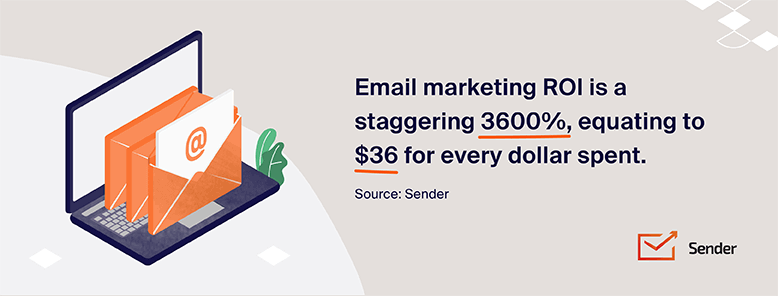
Why does email marketing work so well from a cost perspective? It’s targeted. Unlike broad advertising that wastes money reaching people who aren’t interested, email marketing lets you communicate only with people who have shown interest in what you offer. This dramatically improves conversion rates and lowers acquisition costs.
Average Email Marketing Costs in 2025
The investment required for effective email marketing in 2025 spans a wide range depending on your business size, how complex your campaigns are, and your implementation methods. The email campaign cost varies widely, but most businesses pay predictable amounts based on their approach.
Current market data from Email Vendor Selection’s 2025 Pricing Report shows typical monthly costs:
- $51–$1,000/month for most small to medium businesses
- $751–$1,000/month for companies using sophisticated email tools
- $51–$500/month when hiring a specialized email marketing agency cost for basic campaigns
- $15–$200/hour for freelance email marketing services
For businesses planning their budget based on subscriber numbers, the following email marketing pricing structure represents industry averages across major platforms:
| Subscriber Count | Average Monthly Cost |
| 2,500 | $30-$75 |
| 5,000 | $45-$110 |
| 10,000 | $75-$195 |
| 25,000 | $150-$350 |
| 50,000 | $280-$575 |
| 100,000 | $500-$1,200 |
These figures cover standard email platform subscriptions but don’t include extras like design services, strategy development, or advanced analytics that many businesses add to their email marketing budget.
Factors Influencing Email Marketing Costs
Why does one platform’s Basic Plan cost $8/month while others ask for $25? There are a few reasons to consider:
Email List Size
The number of email contacts in your database typically determines the base cost for most email platforms. As your subscriber base grows, costs increase too, though many providers offer volume discounts at higher tiers.
For example, a business with 2,000 subscribers might pay about 1.5 cents per subscriber, while one with 50,000 subscribers might get rates closer to 0.8 cents per subscriber. This bulk email pricing structure helps businesses grow their email programs without costs spiraling out of control.
Subscription Plans
Email marketing pricing packages typically fall into two main categories: subscription-based and pay-as-you-go email marketing models.
Pay-as-you-go vs. subscription-based pricing for email marketing boils down to paying for each email sent versus a recurring fee for a set of features or email/subscriber allowance. Cost per subscriber and/or email volume are key factors in both models, with subscriptions often tiered by subscriber count and PAYG directly tied to email volume.
Subscription plans also typically come in tiers:
Basic plans ($15-$50/month):
- Essential features including standard email templates
- Basic segmentation capabilities
- Fundamental analytics
- Limited features
- Email support only
Pro plans ($50-$200/month):
- Advanced automation workflows
- Deeper analytics and reporting
- A/B testing capabilities
- Integration with other platforms
- Priority support with faster response times
Enterprise plans ($300+/month):
- Custom solutions tailored to specific needs
- Dedicated support representatives
- Advanced security features
- Comprehensive API access
- Service level agreements (SLAs)
- White labeling options
Pay-as-you-go models charge based on how many emails you actually send rather than subscriber count. This typically costs between $0.0005 and $0.01 per email depending on volume and provider. These plans work well for businesses with irregular sending patterns or those with large databases who email subscribers infrequently.
Which approach costs less? It depends on your email strategy and sending habits:
- If you send emails frequently (weekly or more), unlimited-send subscription models usually provide better value.
- If you send occasional campaigns (monthly or quarterly), volume-based pricing might save money.
- If your sending is seasonal or campaign-based, pay-as-you-go offers more flexibility.
Email Volume
The number of emails you send each month significantly impacts costs, especially if you use volume-based pricing models. Transactional messaging, automated sequences, and regular newsletters all contribute to your total send volume.
Businesses implementing sophisticated drip campaigns or customer journey automation may send 10-20 emails per subscriber monthly, substantially increasing costs on volume-based plans. Conversely, companies using more restrained approaches might send only 2-4 emails monthly, keeping volume-related expenses lower.
When considering email blast cost per thousand recipients, typical rates range from $0.50 to $10 depending on your provider and plan structure. This affects your total email blast cost, which can range from a few dollars for small businesses to thousands for enterprises sending millions of messages.
Plan your sending frequency and targeting strategically to optimize this cost factor without sacrificing engagement or conversion opportunities. Consider:
- Sending to smaller, more targeted segments rather than your entire list;
- Prioritizing transactional and triggered emails over mass broadcasts;
- Implementing frequency caps based on engagement levels;
- Using preference centers to let subscribers control email frequency.
Campaign Complexity
The sophistication of your email campaigns directly affects both, platform requirements and labor costs. Basic newsletters require minimal investment in tools and expertise, while complex personalized journeys demand robust technology and specialized skills.
Basic email blasts with standardized content typically need only entry-level platform capabilities costing $20-$100 monthly. But implementing multi-step automations with conditional logic, personalized content, and behavioral triggers requires advanced platforms costing $100-$500+ monthly, plus the expertise to configure these systems.
Does advanced complexity justify the additional cost? It depends entirely on your business goals and audience. Evidence from Epsilon’s 2024 Email Marketing Research shows sophisticated personalization can increase conversion rates by 30-50% compared to basic campaigns, potentially justifying higher investment for businesses with substantial average order values or lifetime customer values.
Consider this comparison – a retail business sending basic promotional emails might spend money on a basic email platform costing $200 monthly.
A SaaS company implementing complex onboarding, retention, and upsell sequences might invest $600 monthly for advanced capabilities. So, the SaaS company might see dramatically different engagement and conversion metrics that make the higher expense worthwhile.
Common complexity factors that impact costs include:
- Dynamic content that changes based on customer information;
- Behavioral triggers based on website or app interactions;
- Predictive send-time optimization;
- A/B testing at scale across multiple variables;
- Coding only design elements for interactive experiences;
- Advanced segmentation using multiple data points.
Email Platform Choice
Your choice of email marketing platforms cost significantly affects your overall budget. Major providers like Mailchimp, Klaviyo, AWeber, and Campaign Monitor offer different pricing models and feature sets designed for different business types.
Entry-level platforms like Sender provide essential functionality at lower price points, with plans starting around $10-$25 monthly for small lists. Mid-market solutions like Mailchimp and AWeber cost $20-$500 monthly depending on subscriber count and features. Premium specialized platforms like Klaviyo, with advanced ecommerce capabilities, typically start around $30-$50 monthly but quickly scale to $150-$700+ for growing businesses.
For low cost email marketing options, you might explore newer platforms with competitive introductory rates, but always ensure they have the core features you need.
These key factors determine value when comparing platform costs:
- Base subscription price at your current and projected list size;
- Additional costs for advanced features like automation or A/B testing;
- Integration capabilities with your existing technology stack;
- Scalability pricing as your subscriber count grows;
- Deliverability reputation and inbox placement rates;
- Support quality and availability;
- Template options and customization capabilities.
Take advantage of advanced tools like automation, segmentation, and a drag-and-drop builder with Sender. The best part? It’s free!
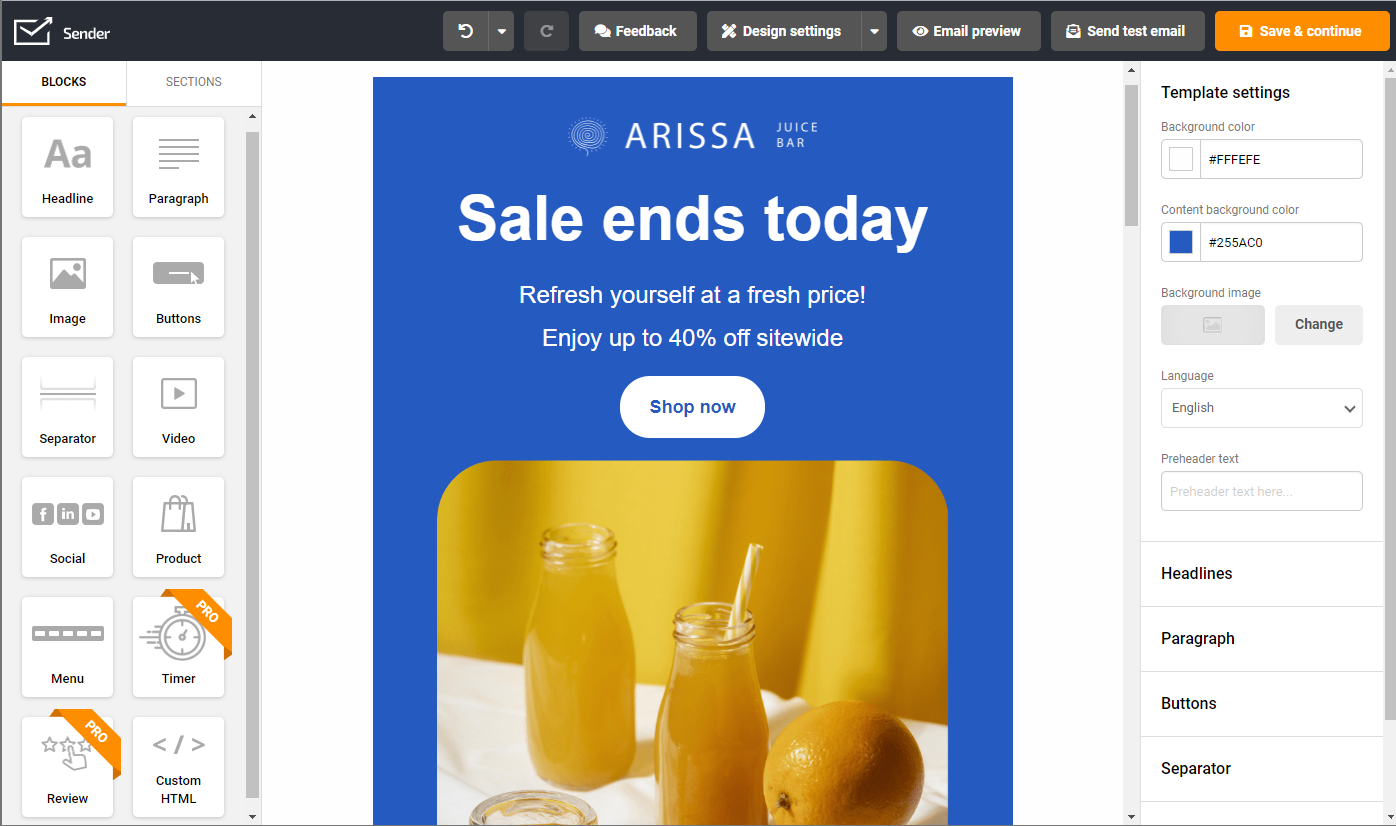
In-House vs. Outsourcing
Handling email marketing internally or hiring external help dramatically affects your cost structure.
In-house email marketing typically requires:
- Platform subscription costs ($30-$500+ monthly);
- Staff time for campaign development (10-30 hours monthly);
- Design resources for template creation and maintenance;
- Content creation time for email copywriting and crafting subject lines;
- Technical expertise for integration management.
By contrast, outsourcing to an email marketing agency might cost $500-$5,000 monthly but eliminates the need for internal expertise and tool investments. Freelance specialists charging $15-$200 hourly provide targeted expertise without the overhead of full-time staff.
For businesses with consistent, high-volume email needs, building internal capabilities often costs less long-term. However, companies with irregular campaigns or specialized needs frequently find better value in external resources that provide on-demand expertise.
When comparing in-house vs. outsourcing costs, consider these factors:
- Your current team’s technical capabilities and available time;
- The complexity of your planned email campaigns;
- The frequency of your email sending;
- Your need for specialized design or copywriting;
- Integration requirements with your other systems;
- Your budget’s preference for fixed costs vs. variable expenses.
How Email Marketing Costs Scale with Business Size
As organizations grow, their email marketing requirements—and associated costs—evolve in predictable patterns. Understanding these scaling factors helps businesses forecast expenses and make appropriate infrastructure decisions.
Small businesses (under 10,000 subscribers)
Small businesses typically operate with straightforward email marketing budgets ranging from $100-$500 monthly. At this scale, costs primarily cover:
- Basic platform subscriptions;
- Occasional template customization;
- Limited time from general marketing staff.
Small businesses focus on finding platforms offering good functionality at entry-level prices, often utilizing limited free versions to establish initial processes before upgrading to paid platform options.
Medium businesses (10,000-50,000 subscribers)
Medium businesses see costs expand to $500-$2,000 monthly as they implement more sophisticated strategies. At this stage:
- Dedicated email marketing personnel become common, adding $40,000-$70,000 in annual staffing costs;
- Integration with CRM systems and ecommerce platforms becomes essential;
- Development expenses during implementation may add one-time costs;
- Advanced segmentation and automation require more robust platforms;
- A/B testing and optimization become regular practices;
- Specialized design resources are often needed for template creation.
Large enterprises (50,000+ subscribers)
Large enterprises typically invest $2,000-$10,000+ monthly in advanced email systems. Enterprise implementations involve:
- Advanced platform subscriptions with custom pricing agreements;
- Custom development work and specialized consulting;
- Enterprise-grade security requirements and compliance monitoring;
- Complex approval workflows spanning multiple departments;
- International compliance considerations and legal oversight;
- Dedicated email teams handling everything from content calendars to deliverability;
- Deep integration with other marketing technologies in the enterprise stack.
The transition between these tiers represents critical decision points for email marketing budget planning, often requiring reassessment of platform choices, staffing models, and agency relationships to maintain cost efficiency.
Email Marketing Price Comparison
Let’s see how much you can expect to pay and receive in return:
Email Marketing Platforms
Selecting the right email service provider requires evaluating pricing structures against your specific feature needs and growth projections. Below, we examine email marketing rates among leading providers based on current market offerings according to G2’s 2025 Email Marketing Software Grid.
| Feature/Plan | Sender | Mailchimp | Klaviyo | AWeber |
| Starting Price | $9/month (2.5K) | $20/month (0.5K) | $20/month (0.25K) | $16.15/month (0.5K) |
| 10K Subscribers | $60/month | $105/month | $150/month | $69/month |
| 25K Subscribers | $115/month | $230/month | $375/month | $149/month |
| Free Plan | Up to 2,500 subs | Up to 500 subs | Up to 250 subs | No |
| Automation | Basic on free, full on paid | Limited on basic, full on premium | Full on all paid plans | Full on all paid plans |
| Ecommerce | Basic integration | Advanced with higher tiers | Advanced with all plans | Basic integration |
These comparisons reveal significant variations in how providers structure their pricing for similar subscriber counts.
- Klaviyo pricing positions it as a premium solution with specialized ecommerce capabilities justifying higher rates;
- Sender offers more benevolent pricing and generous feature package to gain market share;
- Mailchimp pricing reflects their established market position and brand recognition;
- AWeber pricing targets small businesses with moderate scaling costs.
Beyond the baseline subscription costs, each platform offers distinct advantages for specific business types:
- Klaviyo works best for ecommerce operations requiring sophisticated product recommendation engines;
- Sender provides excellent value for content-focused businesses prioritizing deliverability;
- Mailchimp offers strong design capabilities and user-friendly interfaces;
- AWeber provides reliable deliverability and strong customer support.
When comparing social media marketing to email marketing from a cost perspective, email typically delivers acquisition costs 40-60% lower according to recent comparative studies. While social media excels at awareness building and top-of-funnel engagement, email marketing demonstrates superior conversion rates and customer retention metrics at lower implementation costs.
Many businesses achieve optimal results by using social media for audience building and email for nurturing and conversion.
Email Marketing Agency
Partnering with specialized agencies for email marketing execution represents a significant investment but eliminates the need for internal expertise development and platform management.
Current market rates for agency services typically fall between $2,500-$10,000 monthly depending on campaign volume, complexity, and required services.
Entry-level agency engagements starting around $1,000-$2,500 monthly typically include:
- Campaign calendar management;
- Basic template design and maintenance;
- Standard content development;
- Regular performance reporting.
Mid-tier partnerships ($2,500-$5,000 monthly) expand these services to include:
- Advanced segmentation strategy;
- Customer journey development;
- A/B testing programs;
- Deeper analytics and optimization.
Premium agency relationships ($5,000-$10,000+ monthly) provide comprehensive management including:
- Full-service strategy development;
- Custom coding for interactive elements;
- Integration with broader marketing initiatives;
- Deliverability monitoring and management.
When evaluating agencies, consider the cost of constant contact with a dedicated team versus managing campaigns in-house. According to the 2024 Analysis of Agency Costs Survey Report, businesses with 20,000+ subscribers working with specialized agencies report average annual returns 22% higher than those managing email marketing in-house, despite the higher initial investment.
This improved performance stems from several agency advantages:
- Specialized expertise in deliverability optimization;
- Advanced segmentation techniques not available in-house;
- Continuous testing methodologies that internal teams often lack resources to develop;
- Access to specialists across design, copywriting, and technical implementation;
- Experience across multiple clients and platforms10,000 monthly depending on campaign volume, complexity, and required services.
Freelance Services
For businesses seeking specialized expertise without agency overhead, freelance email marketing professionals offer flexible engagement models typically structured around hourly rates or project-based fees.
Freelance email marketing specialists command varying rates based on expertise level:
- Junior specialists: $15-$50/hour
- Mid-level experts: $50-$100/hour
- Senior strategists: $100-$200/hour
Many businesses adopt hybrid models, maintaining platform subscriptions and basic operations in-house while engaging freelancers for specialized projects like:
- Automation setup and configuration;
- Deliverability troubleshooting;
- Strategic audits and recommendations;
- Template redesign and optimization;
- Special campaign development.
This approach provides access to expert guidance without the commitment of full-service agency relationships.
The freelance model works particularly well for businesses with irregular campaign schedules or those requiring specialized expertise for specific initiatives while handling routine execution internally.
Hidden Costs of Email Marketing
Beyond obvious subscription and service fees, comprehensive email marketing budget planning must account for several less apparent cost factors that significantly impact total investment:
Integration expenses often surprise businesses implementing new email platforms. While most providers advertise seamless connections with popular CRMs and e-commerce systems, complex integrations frequently require:
- Development resources costing $500-$5,000;
- Ongoing maintenance as systems are updated;
- Custom API work for non-standard connections;
- Staff time for testing and troubleshooting.
Custom template development represents another significant hidden expense:
- Standard templates often don’t match brand guidelines;
- Professional design services cost $500-$2,500;
- Ongoing maintenance as brand guidelines evolve;
- Additional costs for responsive/mobile optimization.
Email advertising cost often extends beyond just the platform fees when you factor in all these additional considerations.
Free or Low-Cost Email Marketing Solutions
For businesses with limited marketing budgets or those just beginning their email marketing journey, several cheap email marketing platforms offer free or low-cost options with varying capabilities and limitations:
| Platform | Free Plan Limit | Key Limitations | Upgrade Path |
| Sender | 2,500 subscribers | Sender branding, limited support | $7/month for removal |
| Mailchimp | 500 subscribers | Limited templates, no automation | $18/month for automation |
| Klaviyo | 250 subscribers | Limited sends, reduced support | $20/month for full access |
| AWeber | No free plan | 14-day trial only | $13/month minimum |
| Constant Contact | No free plan | 60-day trial only | $12/month minimum |
These entry-level solutions provide viable starting points for small businesses or solopreneurs testing email marketing strategies before committing to paid solutions.
When evaluating free plans, carefully assess limitations that might constrain marketing: effectiveness:
- Sending volume restrictions;
- Template variety and customization options;
- Automation capabilities;
- Analytics and reporting depth;
- Segmentation possibilities;
- Deliverability monitoring;
- A/B testing availability.
Businesses leveraging free plans should develop migration strategies before reaching subscriber limits to ensure seamless transitions when upgrades become necessary.
For organizations with highly limited budgets but growing needs, several bulk email services offer nonprofit discounts (typically 15-25%) or educational pricing that can make premium features accessible at reduced rates for qualifying organizations.
Tips for Email Marketing Cost Reduction
If there’s a set price, it doesn’t mean that you can’t get more out of what you pay for. Here’s how:
Pick a Platform for Your Needs and Budget
Begin by thoroughly documenting your specific requirements, distinguishing between essential features and “nice-to-have” capabilities. For instance, a content publisher might prioritize newsletter templates and scheduling flexibility, while an ecommerce business requires robust product integration and abandoned cart functionality.
Evaluate platforms offering month-to-month contracts initially, allowing you to test capabilities before committing to annual agreements that typically provide 10-20% savings but reduce flexibility. As your strategy matures, annual commitments can reduce your email marketing budget while providing cost certainty.
Consider your growth trajectory when selecting platforms. Migration between systems typically costs $1,000-$5,000 in technical resources and temporary performance disruption, making it economical to select platforms that accommodate 12-24 months of projected growth rather than focusing exclusively on current requirements.
The pricing structure you choose should align with your business model and sending behavior for optimal cost-efficiency.
Leverage Free and Trial Versions
Most major email marketing platforms offer generous free trials (14-60 days) or forever free versions with subscriber limitations. These options provide valuable opportunities to thoroughly evaluate platform fit before financial commitment.
During trial periods, test all critical workflows rather than basic functionality. Configure sample automation sequences, experiment with segmentation capabilities, and evaluate analytics depth to ensure the platform meets your comprehensive needs rather than just surface-level requirements.
Many providers also offer free version options for businesses with limited subscriber bases. These free trials enable new businesses to establish email marketing programs without initial investment, then transition to paid plans as subscriber numbers grow and feature requirements expand.
Regularly Clean and Segment Your Email List
List maintenance represents one of the most effective cost-control measures for subscription-based email marketing platforms. Regular removal of inactive subscribers can significantly reduce monthly expenses while simultaneously improving engagement metrics and deliverability rates.
Implement quarterly reengagement campaigns targeting subscribers showing no activity for 90+ days. Those who remain unengaged after specific reactivation attempts should be removed from active sending lists.
Advanced segmentation strategies allow targeted communication rather than broad-based sending to entire databases. By delivering specific messages only to relevant subscriber segments, businesses reduce unnecessary send volume while improving engagement rates—a dual benefit affecting both cost and performance.

For businesses using volume-based pricing models, implementing preference centers enabling subscribers to select content categories and frequency preferences can substantially reduce send volume while improving relevance and engagement—directly impacting both costs and effectiveness.
Utilize Automation To Reduce Manual Efforts
Strategic automation implementation can dramatically reduce the labor costs associated with email marketing while improving campaign performance and consistency. Automated workflows eliminate repetitive tasks that typically consume 5-15 hours weekly for marketing teams managing manual campaigns.
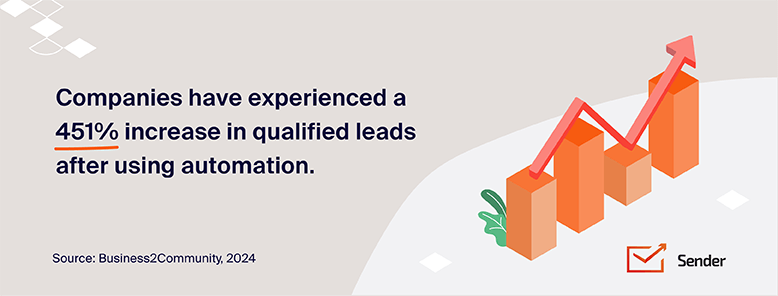
Begin with fundamental automation sequences delivering reliable returns:
- Welcome series for new subscribers;
- Abandoned cart recovery (for e-commerce);
- Post-purchase follow-up sequences;
- Renewal or replenishment reminders.
These baseline automations typically generate 30-40% of email-attributed revenue while requiring only initial setup and periodic optimization rather than ongoing campaign development.
Advanced behavioral triggers based on website interactions, purchase history, or engagement patterns further expand automation capabilities. These sophisticated sequences may require more substantial initial investment but operate with minimal ongoing maintenance while delivering highly relevant communications.
For businesses with limited technical resources, template-based automation systems offering pre-configured sequences require minimal customization while providing much of automation’s efficiency benefit without specialized expertise requirements.
Summary
Email marketing continues to represent one of the most cost-effective channels available to modern businesses, with implementation costs ranging from under $100 monthly for small operations to several thousand dollars for enterprise-scale programs. The key to maximizing return on this investment lies in strategic platform selection, efficient resource allocation, and continuous optimization of both technical and content elements.
As we progress through 2025, businesses face an increasingly sophisticated email marketing landscape requiring thoughtful budget allocation. The fundamental value equation remains compelling—no other digital channel consistently delivers comparable returns across industries and business models. With average returns of $36 per dollar invested and even higher performance in select sectors, email marketing ROI justifies continued investment even as costs for advanced capabilities increase.
For businesses looking to optimize email marketing costs without sacrificing performance, Sender offers a powerful mix of affordability, robust features, and scalability—typically 30-40% cheaper than comparable solutions.
